January 8, 2023 | Wild Ride of US Auto Sales in 2022 below 1977. Charts for GM, Toyota, Ford, Stellantis, Hyundai-Kia, Honda, and Nissan oh Dear

The thing about new vehicle sales in the US is that even in good years, they’re bad, and in bad years, they’re terrible.
In 2022, total new vehicles delivered to retail customers and fleets (dominated by rental fleets), fell by 8% from the already terrible 2021, to 13.7 million vehicles, below where deliveries had been in 1977, down 16.4% from the peak in 2016, and down 20.8% from the prior peak in the year 2000. This makes for 45 years of stagnation with steep plunges in between.
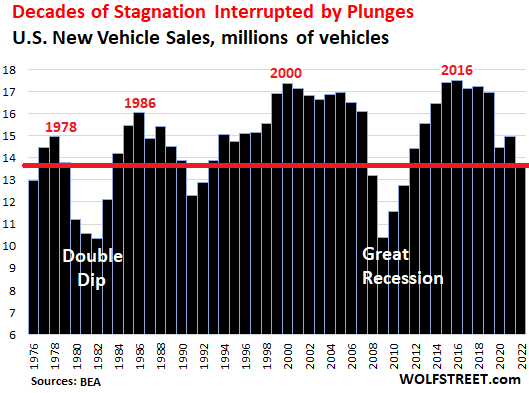
The way automakers have gotten their dollar-revenues to rise over the decades in this environment of stagnating or plunging unit sales is to sell more expensive vehicles, going upscale with ever fancier, more advanced, better-performing, more efficient, better equipped, and safer vehicles – I mean, even the base F-150 pickup truck now has a 10-speed automatic transmission, that kind of thing.
But already years ago, going upscale and ever-higher prices started to contribute to the stagnation as there appears to be a shortage of upscale Americans.
But 2022 was extra-special: chip shortages & shift in demand to fuel-efficient cars.
The semiconductor shortages began to bite in late 2020, got a lot worse in 2021, and dragged into 2022, and they’re still going on, though to a lesser extent.
In this environment, when automakers could get the semiconductors they needed, they could build vehicles and sell them, and their sales were strong – Toyota through September 2021, Hyundai and Kia in 2021 and 2022, nice to have great relations with Korean semiconductor makers. And when they ran out of just one of the thousands of semiconductors in a model, they couldn’t build this model, and there was nothing to sell, dealer inventories were depleted, and their sales plunged – Honda and Toyota in 2022. The big US automakers had trouble throughout.
In addition, powered by the surge in gasoline prices in early 2022, vehicle demand suddenly shifted to fuel-efficient vehicles, especially small and mid-size cars and compact SUVs, and to EVs by legacy automakers that they couldn’t build enough of. Supply chains and production weren’t ready at all to accommodate this shift.
So the inventory shortages have shifted in 2022 from pickup trucks and SUVs, which had vanished from dealer lots in 2021 and of which there is now ample supply, to fuel-efficient vehicles, and dealers ran out of those vehicles in 2022.
Overall inventory through November has come up to 1.64 million vehicles, but was still down by 54% from November 2019, according to data from Cox Automotive:
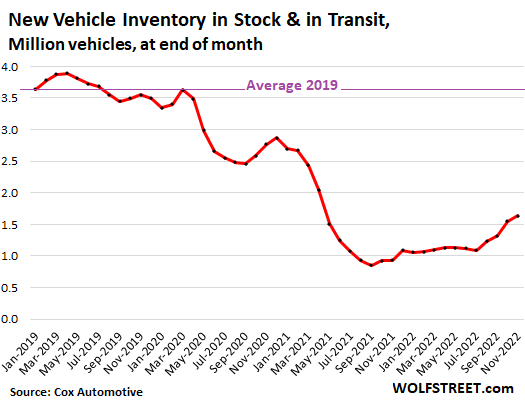
Shortages entailed price spikes.
In the classic manner, the MSRP is set before the new model-year vehicles arrive at the dealer and won’t change after that for the entire model year. In normal years, automakers and dealers pile on discounts, dealer incentives, and customer rebates to stimulate sales (Tesla, which sells direct is the exception; it changes prices on its website whenever).
But in 2021 and 2022, these discounts, dealer incentives, and customer rebates vanished, and dealers were able to sell vehicles at thousands of dollars above MSRP, because those Americans that could afford them were suddenly eager to pay whatever, which they rarely do in normal times.
In addition, automakers that could only build a limited number of vehicles due to the chip shortages prioritized their most expensive models, and they drove up prices on them. And so I ended up writing this crazy article: $1,768 a Month, with $10,407 Down, 5% APR, on a Ford Pickup? Update on Q3 New-Vehicle Finance.
And as a result, average transaction prices after all incentives and addendum stickers spiked by 33% in three years, from $34,900 in December 2019 to $46,400 in December 2022, according to J.D. Power. That price spike has now leveled off.
The chart shows the average transaction prices in June and December every year; the green line connects the Decembers. Note also how the normal seasonality – a dip in average transaction prices in mid-year – totally vanished recently:
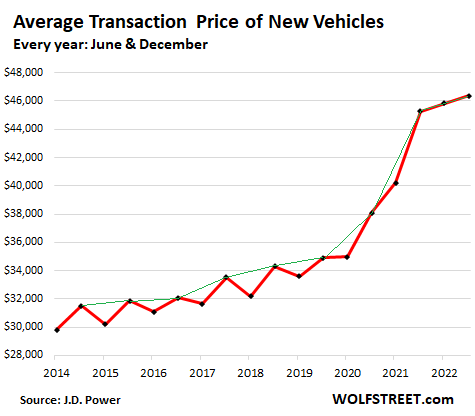
The Wild Ride of the seven biggest automakers in the US.
Note: the first four charts – the big four – are on the same scale to show their relative sales to each other. The remaining three big automakers don’t sell enough to show on these charts, and they got each their own scale.
General Motors: sales rose 2.5% year-over-year to 2.274 million vehicles. But this was down by 26% from its recent peak in 2015, after the plunge in 2020 and 2021, and after the sales declines in each of the four prior years:
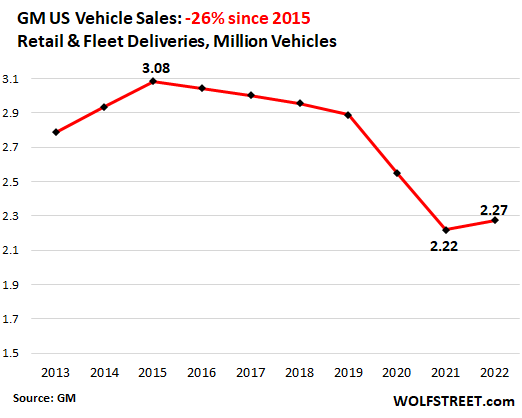
Toyota: Through the first half of 2021, Toyota had plenty of supply of semiconductors thanks to its special contracts with its suppliers. But then it ran out too, and by September 2021, it started running out of vehicles. Nevertheless, the strength through the first three quarters in 2021 was enough to make it #1 in the US for the first time ever.
In 2022, after a series of production cuts, inventory vanished, and sales plunged 9.6%, to 2.11 million vehicles, down by 16% from the recent peak in 2015:
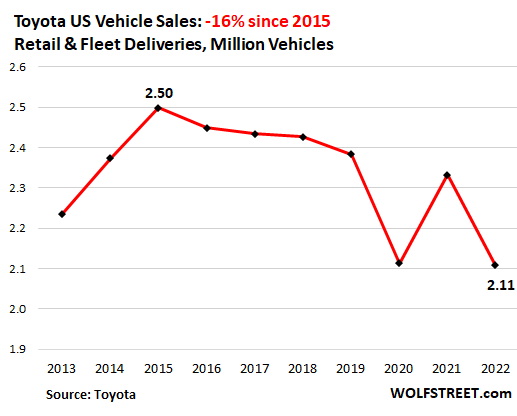
Ford: Sales dropped another 2.2% year-over-year, the 7th year-over-year drop in a row. From the recent peak in 2015, sales have plunged 28%:
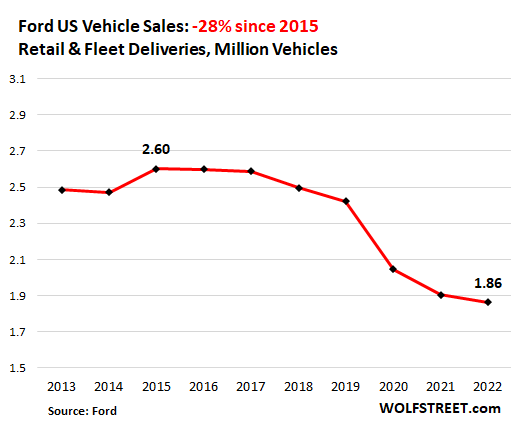
Stellantis (FCA US): Sales dropped 13% year-over-year and have plunged 32% from the recent peak in 2015:
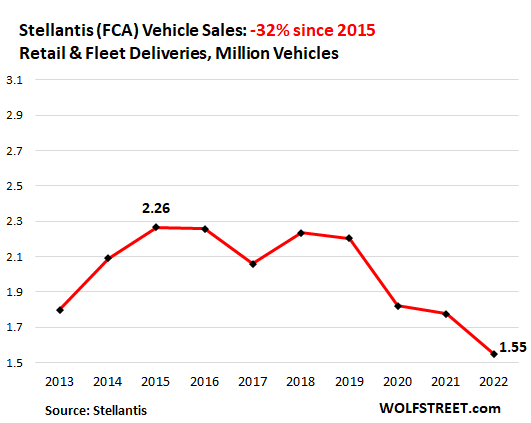
The charts below of the remaining three big automakers in the US are each on their own scale.
Hyundai-Kia: He who can get the chips can build vehicles and has something to sell. It helps that other Korean companies are global powerhouses in semiconductor production. So Hyundai-Kia sales combined hit an all-time record in 2021 and dipped 1.5% from that record in 2022, to 1.42 million vehicles:
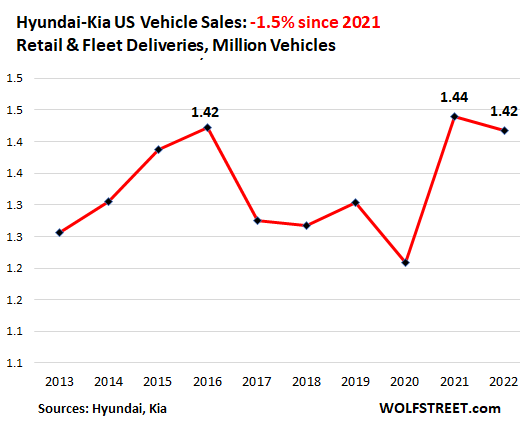
Honda: Similar to Toyota, it was able to get through 2021 in reasonably good shape, but got hit hard by semiconductor shortages in late 2021 and in 2022, and it ran out, and sales collapsed by 33% year-over-year, to less than 1 million vehicles, down by 40% from the peak in 2017:
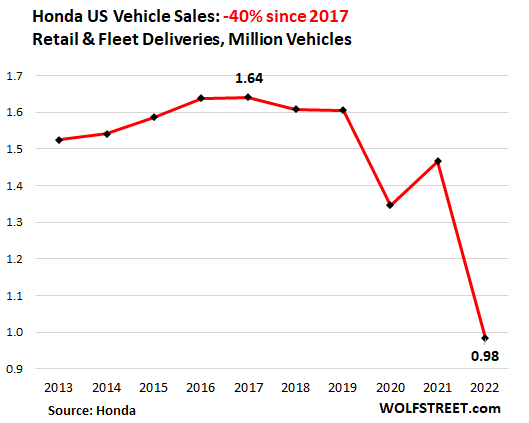
Nissan: Sales plunged 25% year-over-year to 729,000 and by 54% from the peak in 2017. The company already had massive problems before the pandemic, with sales having dropped 16% in the two years from the peak in 2017 through 2019. The pandemic and chip shortages hammered it further:
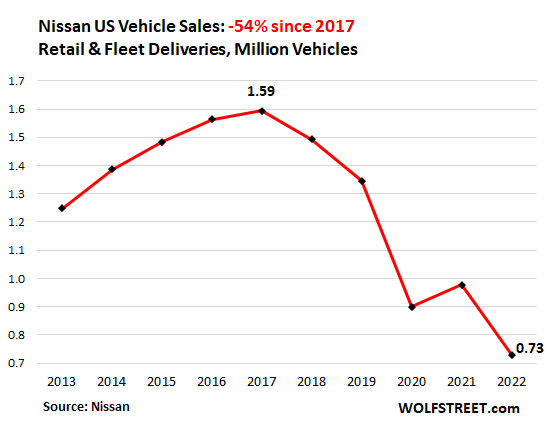
STAY INFORMED! Receive our Weekly Recap of thought provoking articles, podcasts, and radio delivered to your inbox for FREE! Sign up here for the HoweStreet.com Weekly Recap.
Wolf Richter January 8th, 2023
Posted In: Wolf Street











